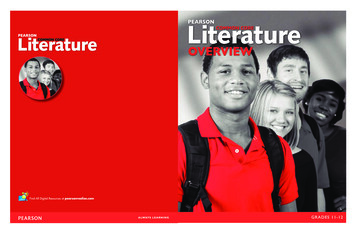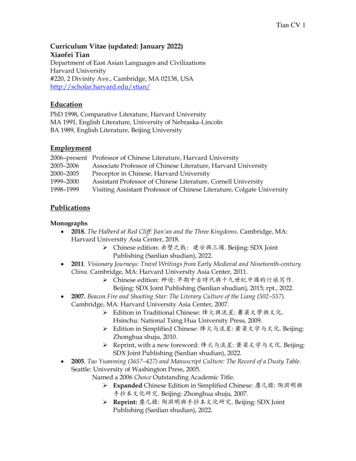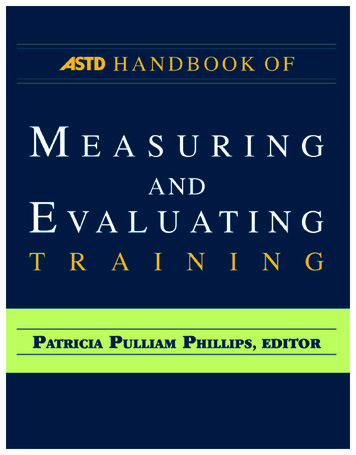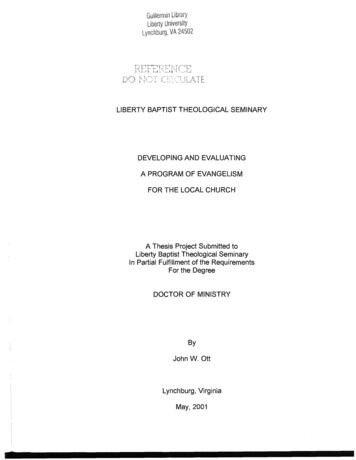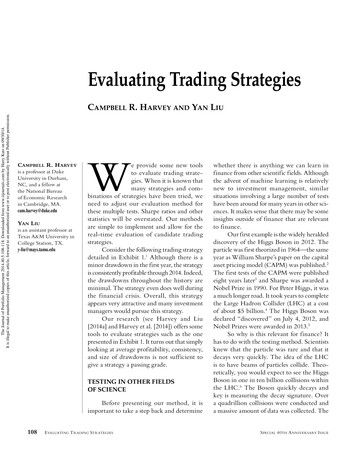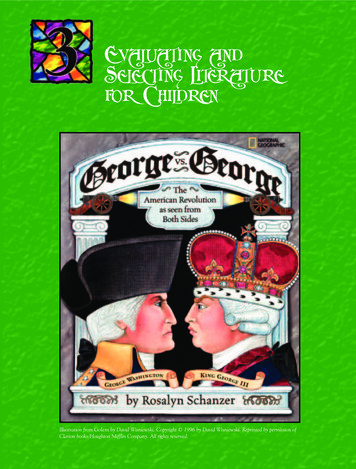
Transcription
EVALUA TING ANDSELECTING L I TERA TUREFOR CHILDRENIllustration from Golem by David Wisniewski. Copyright 1996 by David Wisniewski. Reprinted by permission ofClarion books/Houghton Mifflin Company. All rights reserved.
CHAP TER OU TLINEStandards, LiteraryElements, and BookSelection Standards for EvaluatingBooks and LiteraryCriticismStandards for EvaluatingMulticultural LiteratureLiterary ElementsThe Right Book for EachChildThe Child as CriticTeaching WithLiterary Elements Involving Children in PlotInvolving Children inCharacterizationInvolving Children in SettingInvolving Children in ThemeInvolving Children in StyleWebbing the LiteraryElementsecause thousands of books have beenpublished for children, selectingbooks appropriate to the needs ofchildren can be difficult. Teachersand librarians, who share books withgroups of children as well as with individual children,should select books that provide balance in a school orpublic library. The objectives of literature programs alsoaffect educators’ selections of children’s books.A literature program should have five objectives.First, a literature program should help students realizethat literature is for entertainment and can be enjoyedthroughout their lives. Literature should cater to children’s interests as well as create interest in new topics.Consequently, educators must know these interests andunderstand ways to stimulate new ones.Second, a literature program should acquaint children with their literary heritage. To accomplish this, literature should foster the preservation of knowledge andallow its transmission to future generations. Therefore,educators must be familiar with fine literature from thepast and must share it with children.Third, a literature program should help students understand the formal elements of literature and lead themto prefer the best that our literature has to offer. Childrenneed to hear and read fine literature and to appreciate authors who not only have something to say but also say itextremely well. Educators must be able to identify the bestbooks in literature and share these books with children.Fourth, a literature program should help childrengrow up understanding themselves and the rest of humanity. Children who identify with literary charactersconfronting and overcoming problems like their own learnways to cope with their own problems. Educators shouldprovide literature that introduces children to people fromother times and nations and that encourages children tosee both themselves and their world in a new perspective.Fifth, a literature program should help children evaluate what they read. Literature programs should extendchildren’s appreciation of literature and their imaginations.Therefore, educators should help students learn how tocompare, question, and evaluate the books they read.Rosenblatt (1991) adds an important sixth objective,encouraging “readers to pay attention to their own literary experiences as the basis for self-understanding or forcomparison with others’ evocations. This implies a new,collaborative relationship between teacher and student.Emphasis on the reader need not exclude application ofvarious approaches, literary and social, to the process ofcritical interpretation and evaluation” (p. 61). Childrenneed many opportunities to respond to literature.Susan Wise Bauer (2003) presents a powerful objective for a literature study that encourages readers to understand, evaluate, and express opinions about what isread. This final objective of a literature program, as recommended by Bauer, is to train readers’ minds by teach-
www.prenhall.com/nortoning them how to learn. To accomplish this objective, sherecommends a study of literature that progresses from firstreading a book to get a general sense of the story and thecharacters; to rereading the book to analyze the story, discover the author’s techniques, and analyze any argumentsthe author developed; and, finally, to deciding such questions as Did I sympathize with the characters? Why or whynot? Did I agree or disagree with the ideas in the book?If children are to gain enjoyment, knowledge of theirheritage, recognition and appreciation of good literature,and understanding of themselves and others, they mustexplore balanced selections of literature. A literature program thus should include classics and contemporary stories, fanciful stories as well as realistic ones, prose as wellas poetry, biographies, and books containing factual information. To provide this balance, educators must knowabout many kinds of literature. Alan Purves (1991) identifies basic groups of items usually found in literature programs: literary works, background information, literaryterminology and theory, and cultural information. Hestates that some curricula also include the responses of thereaders themselves.This chapter provides information about numeroustypes of books written for children, and looks at standardsfor evaluating books written for children. It presents anddiscusses the literary elements of plot, characterization,setting, theme, style, and point of view. It also discusseschildren’s literature interests, characteristics of literaturefound in books chosen by children, and procedures to helpchildren evaluate literature.Standards for Evaluating Booksand Literary CriticismAccording to Jean Karl (1987), in true literature,“there are ideas that go beyond the plot of a novel orpicture book story or the basic theme of a nonfictionbook, but they are presented subtly and gently; goodbooks do not preach; their ideas are wound into the substance of the book and are clearly a part of the life of thebook itself” (p. 507). Karl maintains that in contrast,mediocre books overemphasize their messages or theyoversimplify or distort life; mediocre books contain visionsthat are too obvious and can be put aside too easily. If literature is to help develop children’s potential, merit ratherthan mediocrity must be part of children’s experienceswith literature. Both children and adults need opportunities to evaluate literature. They also need supporting context to help them make accurate judgments about quality.Literary critic Anita Silvey (1993) provides both auseful list for the qualities of a reviewer and questions forthe reviewer to consider. She first identifies the characteristics of fine reviewers and fine reviews; these include asense of children and how they will respond to the book aswell as an evaluation that, if the book is good, will makereaders want to read the book. The review should evalu-Evaluation CriteriaLiterary Criticism: Questions to Ask MyselfWhen I Judge a Book1. Is this a good story?2. Is the story about something I think could reallyhappen? Is the plot believable?3. Did the main character overcome the problem, butnot too easily?4. Did the climax seem natural?5. Did the characters seem real? Did I understand thecharacters’ personalities and the reasons for theiractions?6. Did the characters in the story grow?7. Did I find out about more than one side of thecharacters? Did the characters have both strengthsand weaknesses?8. Did the setting present what is actually knownabout that time or place?9. Did the characters fit into the setting?10. Did I feel that I was really in that time or place?11. What did the author want to tell me in the story?12. Was the theme worthwhile?13. When I read the book aloud, did the characterssecond like real people actually talking?14. Did the rest of the language sound natural?(Norton, 1993)ate the literary capabilities of the author and also be written in an enjoyable style. The reviewer needs a sense ofthe history of the genre and must be able to make comparisons with past books of the author or illustrator. Thissense of genre also requires knowledge of contemporaryadult literature, art, and film so that the reviewer is ableto place the book in the wider context of adult literatureand art. The review should also include a balance betweena discussion of plot and critical commentary. A sense ofaudience requires that the reviewer understand what theaudience knows about books. Finally, Silvey recommendsthat a reviewer have a sense of humor; especially whenevaluating books that are themselves humorous.Silvey’s list of questions that the reviewer should consider is divided according to literary questions (How effective is the development of the various literary elements?),artistic questions (How effective are the illustrations andthe illustrator’s techniques?), pragmatic questions (Howaccurate and logical is the material?), philosophical questions (Will the book enrich a reader’s life?), and personalquestions (Does the book appeal to me?).75
76CHAPTER 3Northrop Frye, Sheridan Baker, and George Perkins(1985) identify five focuses of all literary criticism, two ormore of which are usually emphasized in an evaluation ofa literary text:(1) The work in isolation; with primary focus on its form, asopposed to its content; (2) its relationship to its own time andplace, including the writer; the social, economic, and intellectual milieu surrounding it; the method of its printing orother dissemination; and the assumptions of the audiencethat first received it; (3) its relationship to literary and socialhistory before its time, as it repeats, extends, or departs fromthe traditions that preceded it; (4) its relationship to the future, as represented by those works and events that come after it, as it forms a part of the large body of literature,influencing the reading, writing, and thinking of later generations; (5) its relationship to some eternal concept of being,absolute standards of art, or immutable truths of existence.(p. 130)The relative importance of each of the preceding areas toa particular critic depends on the critic’s degree of concern with the work itself, the author, the subject matter,and the audience.Book reviews and longer critical analyses of books inthe major literature journals are valuable sources for librarians, teachers, parents, and other students of children’s literature. As might be expected from the fivefocuses of Frye, Baker, and Perkins, reviews emphasize different aspects of evaluation and criticism. Phyllis K. Kennemer (1984) identified three categories of book reviewsand longer book analyses: (1) descriptive. (2) analytical,and (3) sociological. Descriptive reviews report factual information about the story and illustrations of a book. Analytical reviews discuss, compare, and evaluate literaryelements (plot, characterization, setting, theme, style, andpoint of view), the illustrations, and relationships withother books. Sociological reviews emphasize the socialcontext of a book, concerning themselves with characterizations of particular social groups, distinguishable ethniccharacteristics, moral values, possible controversy, andpotential popularity.Although a review may contain all three types of information, Kennemer concludes that the major sources ofinformation on children’s literature emphasize one type ofevaluation. For example, reviews in the Bulletin of the Center for Children’s Books tend to be descriptive, but they alsomention literary elements. Reviews in Booklist, The HornBook, Kirkus Reviews, and The School Library Journalchiefly analyze literary elements. The School Library Journal also places great emphasis on sociological analysis.The “Annual Policy Statement” for The School LibraryJournal (Jones, 2005) states the selection and evaluationcriteria for the journal: “SLJ’s reviews are written by librarians working directly with children and young adultsin schools or public libraries, library-school educators,teachers of children’s literature, and subject specialists.They evaluate books in terms of literary quality, artisticmerit, clarity of presentation, and appeal to the intendedaudience. They also make comparisons between new titlesand materials already available in most collections andmention curriculum connections” (p. 84).For example, the following analysis for Uri Schulevitz’s The Travels of Benjamin of Tudela: Through ThreeContinents in the Twelfth Century was written by MargaretA. Chang (April 2005). As you read this analysis of a bookthat merited a starred review, notice the type of information the reviewer provides: “Grade 4–8—Benjamin, aSpanish Jew, left his native town of Tudela in 1159 to embark on a 14-year journey across the Middle East. HisBook of Travels, written in Hebrew, recounts his grueling,often-dangerous journey through what is modem-dayFrance, Italy, Greece, Cyprus, Israel, Syria, Iraq, Iran, andEgypt. Encounters with warring Crusaders and Muslims,rapacious pirates, and bandits added to his hardships.Shulevitz recreates this epic journey in a picture book ofepic proportions, adapting Benjamin’s account into a detailed, first-person narrative, accompanied by large, ambitious illustrations that evoke the landscapes, people,architecture, and history of the places that Benjamin saw.Darker, freer, and more impressionistic than Shulevitz’s familiar work, the art is often indebted to medieval manuscript painting and Persian miniatures. Meticulouslyresearched, with a long bibliography, lengthy author’snote, and brief insets containing information that complements Benjamin’s descriptions, this oversize picturebook is obviously a labor of love. Wherever he went, Benjamin visited Jewish communities. Shulevitz’s retellingstands as a testimony to the history, wisdom, and fortitudeof those medieval Jews living precariously under Christianor Muslim rule. Both art and text will help readers imagine life during that time, and perhaps provide a context forthe contemporary turmoil in the lands Benjamin visited solong ago” (p. 142).Selection criteria and reviews in specific journals alsoemphasize the particular content and viewpoints of thegroup that publishes the journal. For example, each year,the National Council for the Social Studies selects booksfor grades 4–8 that emphasize human relations and aresensitive to cultural experiences, present an originaltheme, are of high literary quality, and have a pleasingformat and illustrations that enrich the text.Reading and discussing excellent books as well as analyzing book reviews and literary criticism can increaseone’s ability to recognize and recommend excellent literature for children. Those of us who work with students ofchildren’s literature are rewarded when for the first timepeople see literature with a new awareness, discover thetechniques that an author uses to create a believable plotor memorable characters, and discover that they can provide rationales for why a book is excellent, mediocre, orpoor: Ideally, reading and discussing excellent literaturecan help each student of children’s literature become aworthy critic. The Evaluation Criteria presented onpage 000 suggest the type of criteria that are useful forboth teachers and librarians when selecting books and forstudents when they are criticizing the books they read.
www.prenhall.com/nortonTechnology ResourcesYou can use the CD-ROM that accompanies this text toprint a list of Carnegie award winners: Simply searchunder Awards, type in “Crn” (award name abbreviationsare listed under Field Information on the Help menu).In addition to books that are chosen for various literary awards such as the Newbery, the Carnegie, and theHans Christian Andersen Award, students of children’sliterature can consider and discuss the merits of booksidentified by Karen Breen, Ellen Fader, Kathleen Odean,and Zena Sutherland (2000) on their list of the 100 booksthat they believe were the most significant for childrenand young adults in terms of shaping the 20th century.When citing their criteria for these books, they state: “Wedecided that our list should include books with literaryand artistic merit, as well as books that are perenniallypopular with young readers, books that have blazed newtrails, and books that have exerted a lasting influence onthe world of children’s book publishing” (p. 50).Of the 100 books on the list, 23 were selected unanimously by all four of the experts on the first round ofballoting: these 23 are listed in Chart 3.1. As you maynotice when you read this list, the books range from picCHART 3.1 Twenty-three significant children’s books thatshaped the 20th centuryAuthorBook TitleNatalle BabbittLudwig BemelmansJudy BlumeTuck EverlastingMadelineAre You There God? It’s Me,MargaretGoodnight MoonThe Chocolate WarHarriet the SpyAnne Frank: The Diary of aYoung GirlLincoln: A PhotobiographyJulie of the WolvesThe Snowy DayFrom the Mixed-Up Files of Mrs.Basil E. FrankwellerA Wrinkle in TimeThe Lion, the Witch and theWardrobeFrog and Toad Are FriendsSarah, Plain and TallWinnie-the-PoohIsland of the Blue DolphinsBridge to TerabithiaThe Tale of Peter RabbitWhere the Wild Things AreThe Cat in the HatCharlotte’s WebLittle House in the Big WoodsMargaret Wise BrownRobert CormierLouise FitzhughAnne FrankRussell FreedmanJean Craighead GeorgeEzra Jack KeatsE. L. KonigsburgMadeleine L’EngleC. S. LewisArnold LobelPatricia MacLachlanA. A. MilneScott O’DellKatherine PatersonBeatrix PotterMaurice SendakDr. SeussE. B. WhiteLaura Ingalls Wilderture storybooks for young children to novels for olderreaders. They also include all of the various genres of literature that are discussed in this textbook. The list provides an interesting discussion for literary elements:Why are these particular books included on such a distinguished list?Alleen Pace Nilsen and Kenneth L. Donelson (2001)warn that adults add another element when evaluatingliterature: “We should caution, however, that books areselected as ‘the best’ on the basis of many different criteria, and one person’s best is not necessarily yours or that ofthe young people with whom you work. We hope that youwill read many books, so that you can recommend themnot because you saw them on a list, but because you enjoyed them and believe they will appeal to a particular student” (p. 11).Standards for EvaluatingMulticultural LiteratureMulticultural literature is literature about racial orethnic minority groups that are culturally and socially different from the white Anglo-Saxon majority in the United States, whose largely middle-class valuesand customs are most represented in American literature.Violet Harris (1992) defines multicultural literature as“literature that focuses on people of color, on religious minorities, on regional cultures, on the disabled, and on theaged” (p. 9).Values of Multicultural LiteratureMany of the goals for multicultural education can be developed through multicultural literature. For example,Rena Lewis and Donald Doorlag (1987) state that multicultural education can restore cultural rights by emphasizing cultural equality and respect, enhance theself-concepts of students, and teach respect for variouscultures while teaching basic skills. These goals for multicultural education are similar to the following goals ofthe UN Convention of the Rights of the Child and citedby Doni Kwolek Kobus (1992):1. understanding and respect for each child’s culturalgroup identities;2. respect for and tolerance of cultural differences,including differences of gender, language, race,ethnicity, religion, region, and disabilities;3. understanding of and respect for universal humanrights and fundamental freedoms;4. preparation of children for responsible life in a freesociety; and5. knowledge of cross-cultural communicationstrategies, perspective taking, and conflictmanagement skills to ensure understanding, peace,tolerance, and friendship among all peoples andgroups. (p. 224)77
78CHAPTER 3Through multicultural literature, children who aremembers of racial or ethnic minority groups realize thatthey have a cultural heritage of which they can be proud,and that their culture has made important contributionsto the United States and to the world. Pride in their heritage helps children who are members of minority groupsimprove their self-concepts and develop cultural identity.Learning about other cultures allows children to understand that people who belong to racial or ethnic groupsother than theirs are individuals with feelings, emotions,and needs similar to their own—individual human beings,not stereotypes. Through multicultural literature, children discover that although not all people share their personal beliefs and values, individuals can and must learn tolive in harmony.Multicultural literature teaches children of the majority culture to respect the values and contributions ofminority groups in the United States and those of peoplein other parts of the world. In addition, children broadentheir understanding of history, geography, and natural history when they read about cultural groups living in various regions of their country and the world. The wide rangeof multicultural themes also helps children develop an understanding of social change. Finally, reading about members of minority groups who have successfully solved theirown problems and made notable achievements helps raisethe aspirations of children who belong to a minoritygroup.Literary Criticism: EvaluatingMulticultural LiteratureTo develop positive attitudes about and respect for individuals in all cultures, children need many opportunitiesto read and listen to literature that presents accurate andrespectful images of everyone. Because fewer children’sbooks in the United States are written from the perspective of racial or cultural minorities and because many stories perpetuate negative stereotypes, you should carefullyevaluate books containing nonwhite characters. Outstanding multicultural literature meets the literary criteriaapplied to any fine book, but other criteria apply to thetreatment of cultural and racial minorities. The followingcriteria related to literature that represents African Americans. Native Americans,* Latino Americans, and AsianAmericans reflect the recommendations of the researchstudies and evaluations compiled by Donna Norton(2005):Are African, Native, Latino, and Asian Americansportrayed as unique individuals, with their own thoughts,emotions, and philosophies, instead of as representativesof particular racial or cultural groups?*This book primarily uses the term Native Americans to denote the people historically referred to as American Indians. The term Indian is sometimes used interchangeably withNative American and in some contexts is used to name certain tribes of Native Americans.Does a book transcend stereotypes in the appearance,behavior, and character traits of its nonwhite characters?Does the depiction of nonwhite characters and lifestylesimply any stigma? Does a book suggest that all members ofan ethnic or racial group live in poverty? Are the characters from a variety of socioeconomic backgrounds, educational levels, and occupations? Does the author avoiddepicting Asian Americans as workers in restaurants andlaundries, Latinos as illegal alien unskilled laborers. Native Americans as bloodthirsty warriors, African Americans as menial service employees, and so forth? Does theauthor avoid the “model minority” and “bad minority”syndrome? Are nonwhite characters respected for themselves, or must they display outstanding abilities to gainapproval from white characters?Is the physical diversity within a particular racial orcultural minority group accurately portrayed in the textand the illustrations? Do nonwhite characters havestereotypically exaggerated facial features or physiquesthat make them all look alike?Will children be able to recognize the characters inthe text and the illustrations as African Americans, Latinos, Asian Americans, or Native Americans and not mistake them for white? Are people of color shown asgray—that is, as simply darker versions of Caucasian-featured people?Is the culture of a racial or ethnic minority group accurately portrayed? Is it treated with respect, or is it depicted as inferior to the majority white culture? Does theauthor believe the culture worthy of preservation? Is thecultural diversity within African American, Asian American. Latino, and Native American life clearly demonstrated? Are the customs and values of those diversegroups accurately portrayed? Must nonwhite charactersfit into a cultural image acceptable to white characters? Isa nonwhite culture shown in an overexotic or romanticized way instead of being placed within the context ofeveryday activities familiar to all people?Are social issues and problems related to minoritygroup status depicted frankly and accurately, withoutoversimplification? Must characters who are members ofracial and cultural minority groups exercise all of the understanding and forgiveness?Do nonwhite characters handle their problems individually, through their own efforts, or with the assistanceof close family and friends, or are problems solved throughthe intervention of whites? Are nonwhite charactersshown as the equals of white characters? Are some characters placed in submissive or inferior positions? Arewhite people always the benefactors?Are nonwhite characters glamorized or glorified, especially in biography? (Both excessive praise and excessivedeprecation of nonwhite characters result in unreal and unbalanced characterizations.) If the book is a biography, areboth the personality and the accomplishments of the maincharacter shown in accurate detail and not oversimplified?
www.prenhall.com/nortonEvaluation CriteriaLiterary Criticism: Multicultural Literature1. Are the characters portrayed as individuals insteadof as representatives of a group?2. Does the book transcend stereotypes?3. Does the book portray physical diversity?4. Will children be able to recognize the characters inthe text and illustrations?5. Is the culture accurately portrayed?Are the illustrations authentic and nonstereotypicalin every detail?Does a book reflect an awareness of the changing status of females in all racial and cultural groups today? Doesthe author provide role models for girls other than subservient females?Notice in the Evaluation Criteria for multicultural literature that in addition to specific concerns about evaluating cultural content, there is also an evaluation of theliterary elements of plot, conflict, characterization, setting, theme, style, and point of view. Also notice that several of the In-Depth Analysis features in this text areabout multicultural titles.6. Are social issues and problems depicted frankly,accurately, and without oversimplification?Literary Elements7. Do nonwhite characters solve their problemswithout intervention by whites?To effectively evaluate literature readers must lookat the ways in which authors of children’s books useplot, characterization, setting, theme, style, andpoint of view to create memorable stories.8. Are nonwhite characters shown as equals of whitecharacters?9. Does the author avoid glamorizing or glorifyingnonwhite characters?10. Is the setting authentic?11. Are the factual and historical details accurate?12. Does the author accurately describe contemporarysettings?13. Does the book rectify historical distortions oromissions?14. Does dialect have a legitimate purpose, and does itring true?15. Does the author avoid offensive or degradingvocabulary?16. Are the illustrations authentic andnonstereotypical?17. Does the book reflect an awareness of the changedstatus of females?Is the setting of a story authentic, whether past, present, or future? Will children be able to recognize the setting as urban, rural, or fantasy? If a story deals with factualinformation or historical events, are the details accurate?If the setting is contemporary, does the author accuratelydescribe the situations of nonwhite people in the UnitedStates and elsewhere today? Does a book rectify historicaldistortions and omissions?If dialect is used, does it have a legitimate purpose?Does it ring true and blend in naturally with the story in anonstereotypical way, or is it simply used as an example ofsubstandard English? If non-English words are used, arethey spelled and used correctly? Is offensive or degradingvocabulary used to describe the characters, their actions,their customs, or their lifestyles?PlotPlot is important in stories, whether the stories reflect theoral storytelling style of Chaucer’s The Canterbury Tales orthe complex interactions in a mystery. When asked to tellabout a favorite story, children usually recount the plot, orplan of action. Children want a book to have a good plot:enough action, excitement, suspense, and conflict to develop interest. A good plot also allows children to becomeinvolved in the action, feel the conflict developing, recognize the climax when it occurs, and respond to a satisfactory ending. Children’s expectations and enjoyment ofconflict vary according to their ages: Young children aresatisfied with simple plots that deal with everyday happenings, but as children mature, they expect and enjoymore complex plots.Following the plot of a story is like following a pathwinding through it; the action develops naturally. If theplot is well developed, a book will be difficult to put downunfinished; if the plot is not well developed, the book willnot sustain interest or will be so prematurely predictablethat the story ends long before it should. The author’s development of action should help children enjoy the story.Developing the Order of Events. Readers expect astory to have a good beginning, one that introduces theaction and characters in an enticing way; a good middlesection, one that develops the conflict: a recognizable climax; and an appropriate ending. If any element is missing, children consider a book unsatisfactory and a wasteof time. Authors can choose from any of several approaches for presenting the events in a credible plot. Inchildren’s literature, events usually happen in chronological order. The author reveals the plot by presenting thefirst happening, followed by the second happening, and soforth, until the story is completed. Illust
nemer (1984) identified three categories of book reviews and longer book analyses: (1) descriptive. (2) analytical, and (3) sociological. Descriptive reviews report factual in-formation about the story and illustrations of a book. An-alytical reviews discuss, compare, and evaluate literary elements



